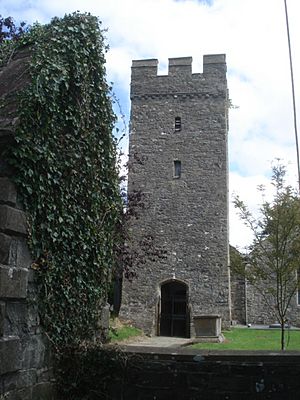Church of St Michael, Cilycwm facts for kids
Quick facts for kids Church of St Michael, Cilycwm |
|
|---|---|
 |
|
| Location | Cilycwm, Llandovery |
| Country | Wales, United Kingdom |
| Denomination | Anglican |
| History | |
| Founded | Medieval |
| Architecture | |
| Heritage designation | Grade I |
| Designated | 7 August 1966 |
| Architectural type | Church |
The Church of St Michael, Cilycwm is a historic church in the village of Cilycwm, near Llandovery, Wales. It serves as the local church for the community. This beautiful building was constructed from rough stones with pink stone decorations. It was first built a very long time ago, between the 1300s and 1400s. Later, between 1905 and 1909, some important repair work was done to keep it in good condition. You can find the church right in the middle of Cilycwm village.
Contents
Discovering St Michael's Church
This church is quite impressive! It has a special design with two main sections, called naves, that run side-by-side. Each nave has its own roof, and there's also a tall, strong tower.
A Look at Its Oldest Parts
The northern part of the church, known as the north nave, is the oldest section. It was built way back in the 1300s. Imagine how many generations have walked through its doors!
The Newer Sections and Special Roof
The southern part of the church, the south nave, was added in the 1400s. This section has a really cool original roof. It's called a "wagon roof" because it looks a bit like the inside of a covered wagon, with curved wooden ribs. The church tower was also built around the same time as the south nave.
Inside the Church
When you step inside, you'll see simple wooden benches (pews) and seats for the choir (stalls). The pulpit, where the priest speaks, has five sides. The rail near the altar has interesting columns that get narrower at the top. Many windows have colorful stained glass, which creates beautiful light inside. There are also some important memorials for people who lived long ago.
Amazing Wall Paintings
One of the most special things about St Michael's Church is its wall paintings. These paintings are in the south aisle, which is a side section of the church. They were created in 1724 and 1795, showing art from different times. These paintings are very rare and make the church unique.
Why St Michael's Church is Important
The Church of St Michael, Cilycwm, is considered a very important historical building. On August 7, 1966, it was given a special status called "Grade I listed building." This means it's one of the most important historic buildings in Wales. It earned this status because it's a great example of a large medieval church. Its 1400s roof is beautiful, and its old wall paintings are very rare and special.

